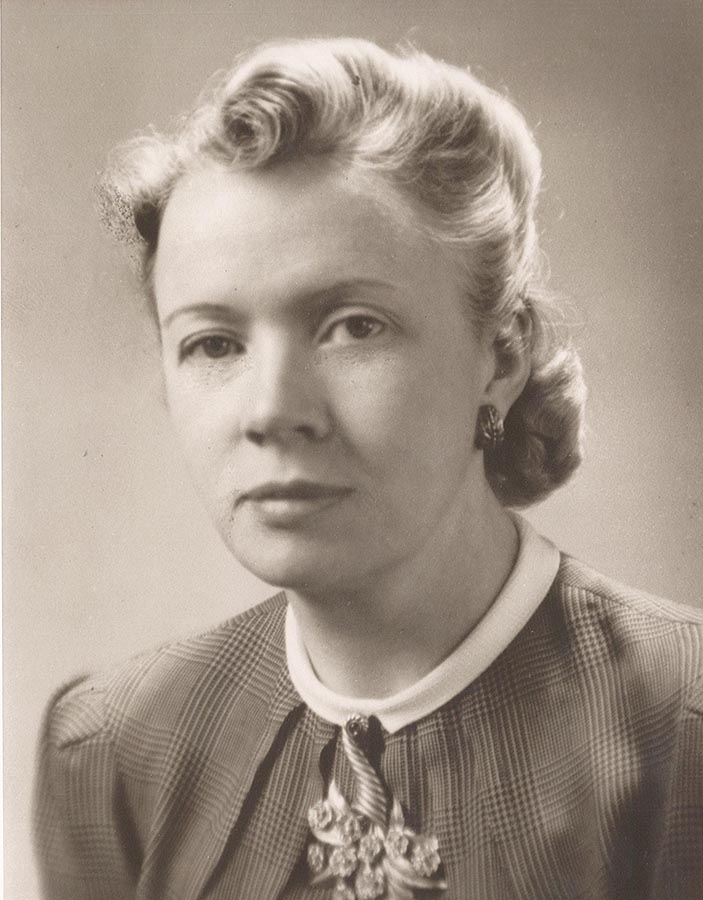
Emelyn Barrett Trimble
Silas Bronson Library Archives
|
Emelyn Barrett,
born and raised in Waterbury, began working at the Silas Bronson during her
senior year at Crosby High School in 1917 and, with the exception of one year
spent studying Library Science at the Pratt Institute in 1924, remained at the
Silas Bronson Library until her retirement in 1971. She became the library’s fifth
director in 1929, replacing Lindsey Brown.
Barrett
married designer Walden Trimble in 1949, but kept her marriage a secret from
the public until her husband died in 1951. Societal convention and library
rules at that time would have required her to quit her job as soon as she was
married. The library’s Board of Agents knew about her marriage and agreed to
allow her to keep her job so long as she pretended to still be unmarried. The
Trimbles were wed in upstate New York and maintained separate residences to
protect Emelyn’s job. Beginning with the death of her husband, she was
officially known as Mrs. Trimble, rather than Miss Barrett.
|
Emelyn
Barrett Trimble led the library through the Great Depression, World War II, and
the construction of the current building during the 1960s. She opened three
library branches, the East End, North End, and Bunker Hill branches, bringing
the total number of library branches to six, in addition to the main library
downtown. She championed the public’s right to read potentially controversial
books, added music and film to the library’s loan collection, and transformed
the library into a research center for students from grade school through
college. At the time of her retirement, she felt that her greatest
accomplishment was the construction of the modern downtown library building.
Branch
Libraries
|

Waterville Branch Library, 1951
Seated at the desk is Librarian Minnie W. Mitchell
Silas Bronson Library Archives
|
Barrett’s
top priority when she took over the leadership of the library was to improve
and expand the branch libraries. In her 1930 annual report, Barrett noted that
many people will use a library only if it is relatively close to them,
stressing the importance of establishing more branch libraries in
well-populated outlying areas of Waterbury.
The
Waterville Branch Library was moved from its original location over a pharmacy
to the annex of the Waterville Fire Station in 1930. The Brooklyn Branch and
Rose Hill Branch both got a makeover during the 1930s and ‘40s.
|
|

North End Branch Library, 1951
Silas Bronson Library Archives
|
In
1937, near the end of the Great Depression, Barrett expressed hope of someday
opening branches in the North End, Bunker Hill, Overlook, Hopeville, Fairlawn,
and West Side Hill (Town Plot). Only sixteen percent of Waterbury’s residents had
library cards; with more branches in the neighborhoods, Barrett anticipated that
at least a third of the city would sign up to use the libraries.
The
East End Branch opened in 1947 in a small storefront next to Hamilton Park. The
North End Branch opened in 1951 on North Main Street near Division Street.
The
Bunker Hill Branch, which opened in 1962, was the first branch library to have
a building constructed specifically for that purpose.
|
School
Deposits and Libraries
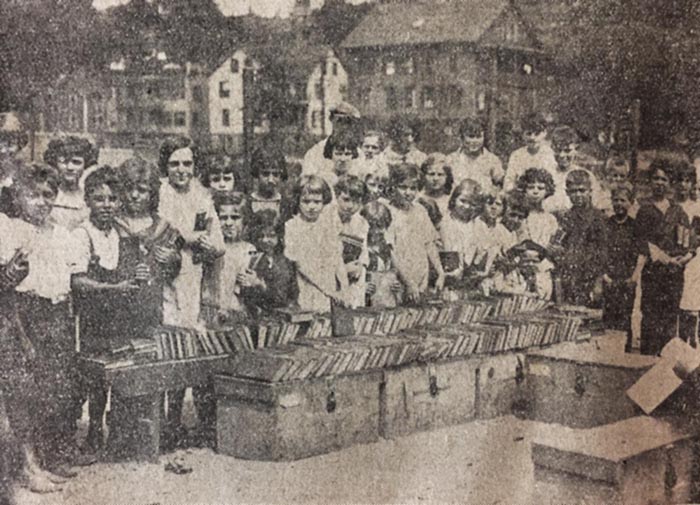
Library Day, Mill Street Playground, 1924
Silas Bronson Library Archives
|
In
1904, the library started a system of delivering books to Waterbury schools,
which didn’t have their own libraries. A box of fifty books would be delivered
each week, giving approximately 40 children each the chance to select a book to
read. During the summer, books were distributed to children at city playgrounds
in the same way.
The
Silas Bronson Library began creating libraries in the schools in 1937, starting
with Woodrow Wilson School, then Chase, Slocum, Walsh, Bishop, Welton, Bunker
Hill, and Driggs Schools over the next several years. The new school libraries
replaced the deposit boxes, setting up a room at each school with hundreds of
books. Children’s librarians from the Silas Bronson staffed the school libraries
one day per week.
|
Great
Depression
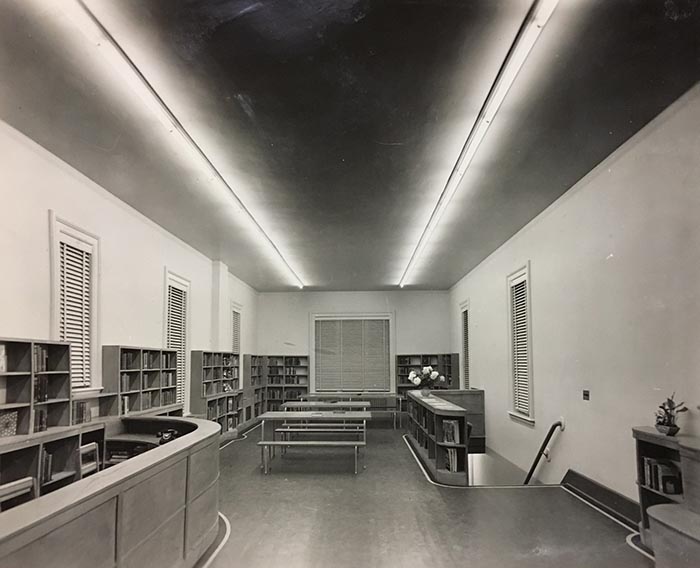
Brooklyn Branch Library, late 1930s
Silas Bronson Library Archives
|
The
library saw an increase in the number of cardholders and an increase in the
number of books borrowed in 1930, attributing the increase to widespread
unemployment and the resultant “enforced idleness of large numbers of people.”
The
library’s annual report for 1930 noted that the “popularity of financial books
is now a thing of the past, due no doubt to the stock market upheaval and
general economic depression.” Financial magazines, however, remained popular.
Despite
the increase in demand, the library’s budget for purchasing new books was
diminished by losses on the stock market. Library books that would normally
have been discarded for being worn out and dirty were kept because there wasn’t
enough money to replace them.
|
In
addition to a reduction in funds for buying books, the library’s municipal appropriation
for salaries was cut by ten percent. Barrett commented in her annual report for
1931 that, although there was no possibility of extending library services, she
hoped the library would meet the “challenge of the depression” in the coming
year as well as it had in the year just ended.
Thanks
to the federally-funded WPA jobs program, Barrett was able to afford to
renovate the main library and branch libraries during the late 1930s, hiring
her future husband, Walden Trimble, to oversee the interior design work.
World
War II
By
1939, as news of the war in Europe grew, the library’s most popular books focused
on conditions in Germany, then Czechoslovakia, Poland, and Finland. Hitler’s Mein
Kampf was popular, but so were several novels about being escaping from the
horrors of the concentration camps and the terrors of life in Nazi-occupied
countries.
Circulation
at the library held steady during the war, even though employment was booming with
the factories running day and night to fill government contracts. The library
more than doubled the number of books they purchased each year following the
lean decade of the Great Depression. Barrett speculated in 1942 that the stress
of the “present national emergency” increased the public’s need to escape into
fiction.
In
1943, after describing the intensity and stress of life on the home front, Barrett
commented that books “can be a stabilizing force in helping people to make the
adjustments necessary for living in the shocking world of today and in the
unknown world of tomorrow.”
|
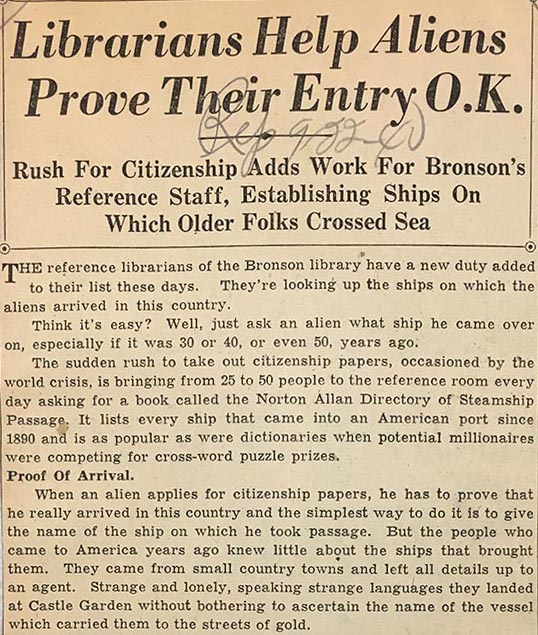
Waterbury Republican, 22 September 1940
Silas Bronson Library WWII Archive
|
Immigrants
began flocking to the library in 1940, in response to a new federal law
requiring “enemy aliens” (immigrants from Germany, Italy, and Japan) to
register with the government. The reference librarians at the Silas Bronson
helped numerous immigrants complete their citizenship applications, helping
them figure out which ship they arrived on and the date of their arrival. For
those who had been in the U.S. for decades, this was a complicated task. One
man who wanted help applying for citizenship arrived in the U.S. half a century
earlier, when he was a child. His parents were no longer living, and he couldn’t
remember the name of the ship or the port he sailed from.
|
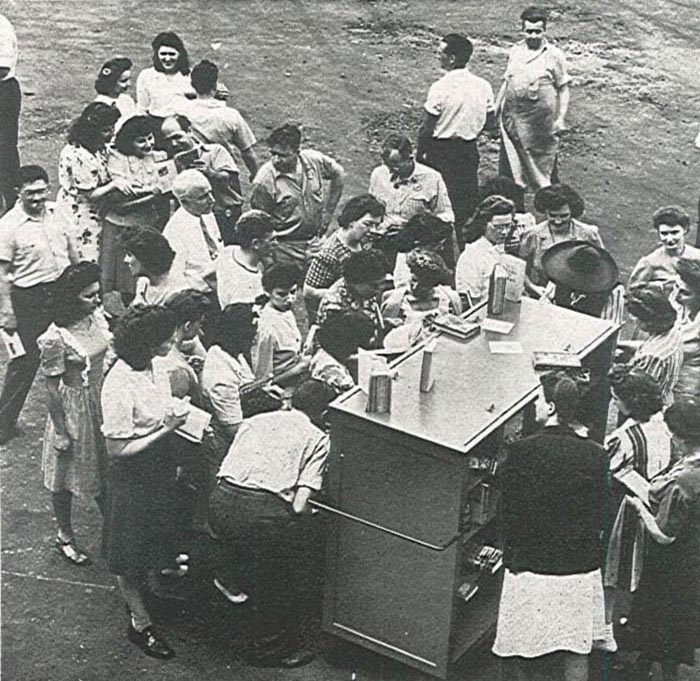
Library Day at a Waterbury factory during WWII
Silas Bronson Library Archives
|
The
branch libraries became a second home to many children, as both parents were
working in the factories. Children using the branch libraries read an average
of 26 books per year; at the newly remodeled Brooklyn branch, they averaged 31
books per year.
In
1943, the library started delivering books to factories every week, making it
easier for the wartime workers to borrow books. Library staff visited during
the day shift, while the factory’s Recreation Department handed out books to
night shift crews at midnight.
|
Victory Book Drive
|
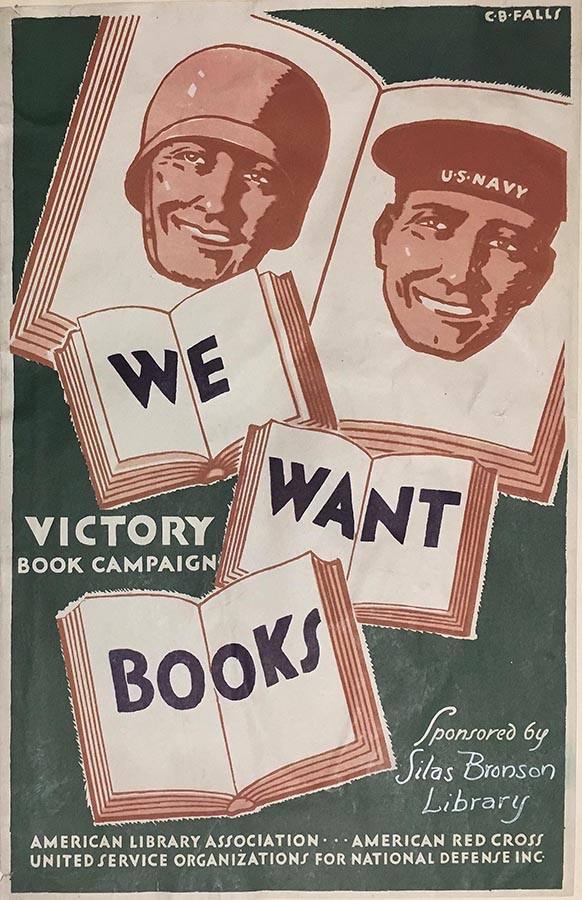
Victory Book Campaign poster, 1942
Silas Bronson Library WWII Archive
|
Starting
in January 1942, Emelyn Barrett was co-chair of the Connecticut branch of the Victory
Book campaign, which aimed to collect ten million books nationwide for USO
houses, army dayrooms, ships, and naval bases. The library teamed up with the
Red Cross, the Boy Scouts, students in 7th and 8th grade,
and four trucking companies to collection 25,000 books for distribution to the
military.
Posters for the
campaign were placed in store windows throughout Waterbury and Wolcott, and
storage rooms at the library were tested to see if they could hold the weight
of the books that would be collected. The books were eventually stored in the
basement of the library.
|
|
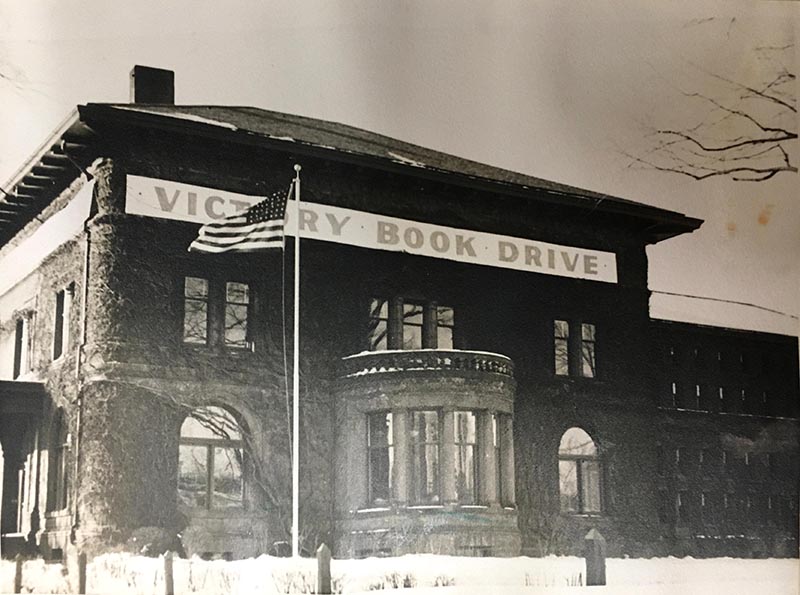
Victory Book Drive sign on the Grand Street
side of the library, January 1942
Silas Bronson Library WWII Archive
|
To help promote
the campaign, the library installed a four-foot-tall sign on two sides of the
building. The sign was created by Murrary McAnelly, a sign painter, with
assistance from library employees Jane Ranando, Guldane Kershian, and Grace
George.
Library
employees and Red Cross volunteers (a total of nearly 800 people) drove through local neighborhoods, going
door to door collecting books on January 23, 1942. Books were also delivered by
the public directly to the library.
|
|
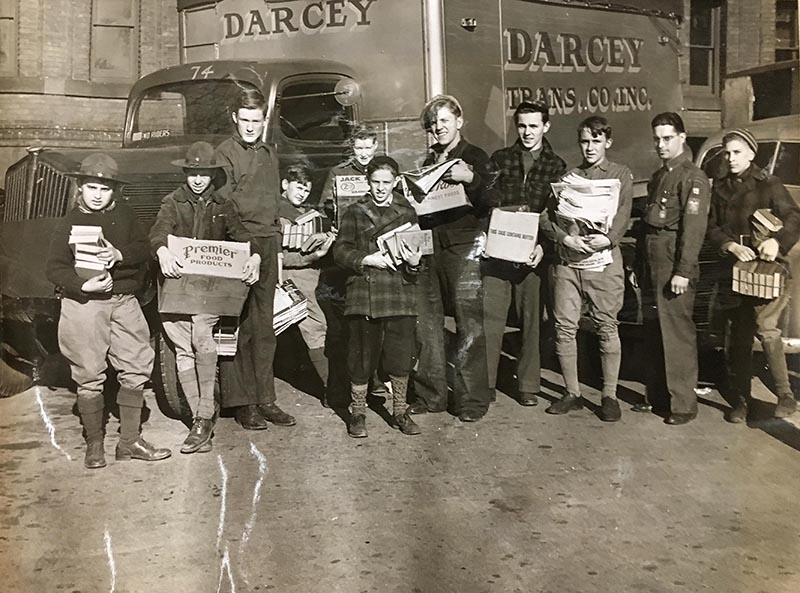
Boy Scouts helping with book donations, 1942
Silas Bronson Library WWII Archive
|
Boy Scout Troop 19, under Scoutmaster Robert Sturges, unloaded and stacked the books as they arrived at the library on January 23.
Within one week’s time, close to 27,000
books were collected by the library. Damaged books were mended by library staff
to make them usable, but most of the books donated were in very good or new
condition.
|
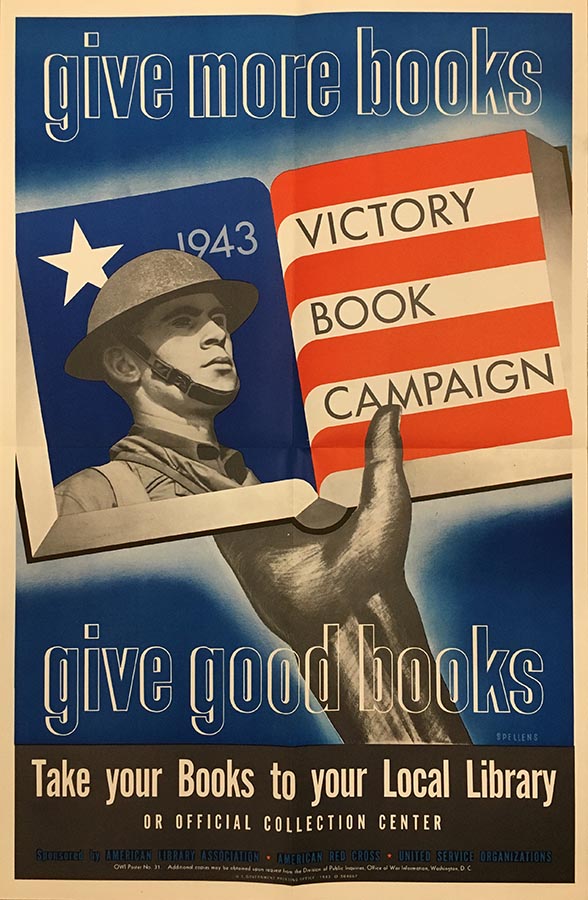
Victory Book Campaign Poster, 1943
Silas Bronson Library WWII Archive
|
A second Victory
Book Campaign was launched in February 1943. Books were collected at the
Victory House on the Green, at neighborhood firehouses, and at local
businesses, as well as at the library. By May 1943, the library had collected
2,200 books for the campaign.
In a letter to
John M. Connor at the Victory Book Campaign Headquarters in NYC, Emelyn Barrett
made a special request for a company of Waterbury men stationed in New Guinea,
who had almost nothing to read. Barrett asked for permission to send the “pocket
edition” books collected in Waterbury to that company. Barrett did not receive
permission to send any books directly to Waterbury’s servicemen overseas, but
she was assured that a large shipment of books would be sent to New Guinea
shortly.
|
Pop Culture
During
the late 1930s, the library started a WPA music appreciation program using a private
record collection and a rented Capehart record player. The program was deemed “one
of the most successful experiments in adult education ever conducted in
Waterbury.” As a result, the library began planning to add recorded music to
its collections in 1941. Barrett’s annual report proposed purchasing a Carnegie
music set, which would include an electric phonograph, 600 record albums, and a
card index of the collection.
The
library’s first music collection, featuring 1400 records donated by Frederick
S. Chase and a Magnavox radio-phonograph donated by the Carnegie Corporation,
was established in 1943. The records could be borrowed for home use, or played
at the library on the radio-phonograph. The library’s music collection at this
point was primarily classical music.
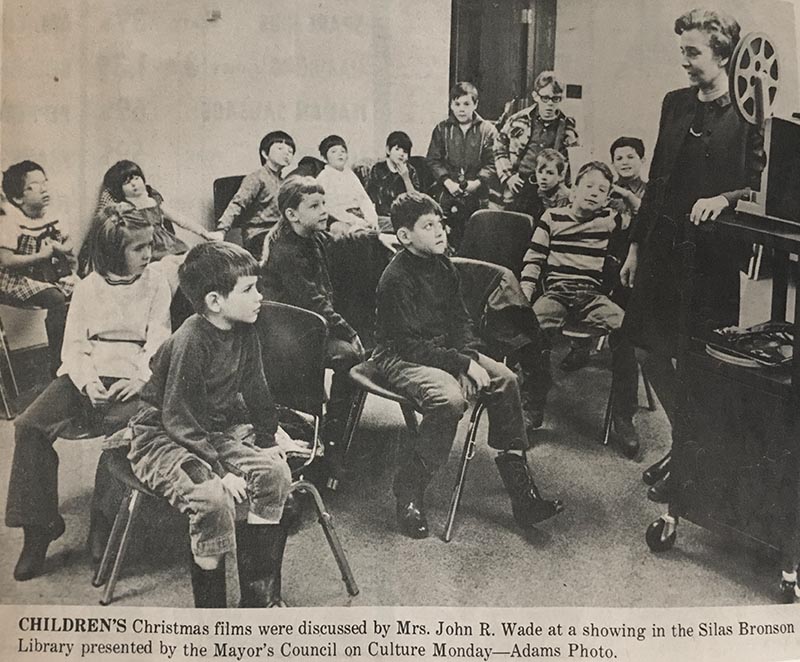
Waterbury Republican, 29 December 1970
Silas Bronson Library Archive
|
During
the 1950s, television emerged as a potential threat to the popularity of
libraries. In an article in the Naugatuck
Daily News on September 19, 1951, Ivy Lovering, head of the Silas Bronson
Library’s children’s department, said that several children had said they were
quitting the library because they had a television at home now – but they all
returned to the library after a few months.
Film became one of the library’s
most popular collection areas in 1971, with more than 5,700 films shown at the
library that year, drawing in over 240,000 people to the library. The library’s
8mm and 16mm film collection was borrowed frequently, primarily by schools,
church and community groups, and convalescent homes.
|
Teens at the Library
During
the 1940s, high school students began using the library with increasing
frequency to work on theme papers and debate topics. By 1942, the library was
considering the creation of a room just for high school students, as the
reference room was often “completely taken over by students,” making it
difficult for adults to concentrate “in such an atmosphere of unrest.”
The
teens of the 1960s, in Waterbury and elsewhere, flocked to the libraries. Waterbury’s
main library downtown was popular with teenagers who would stop by after school
in such “unprecedented numbers” they were crowding out the adults. In 1964,
Barrett noted that the teens were using all areas of the building intended for
adults, because the space set aside for them wasn’t nearly large enough.
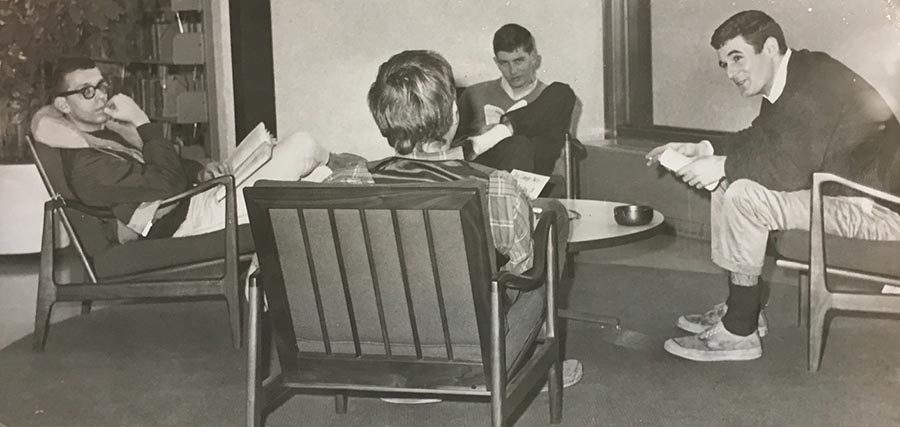
The teen reading area in 1964
Silas Bronson Library Archives
|
A
new Young Adult Department was created to serve the large teen demographic. In
the department’s annual report for 1968, the library declared that “in spite of
all the criticism directed toward teen-agers today, they are a more mature, a
more self-sufficient and a more serious group of library users than ever
before.” Popular nonfiction topics for teens that year included civil
disobedience, Civil Rights, and Vietnam.
The
annual report of 1969 expressed great sympathy for teenagers, who were dealing
with major issues such as “drugs, war, the draft, student unrest and civil
rights.” By 1970, the library was describing teens as “youth in turmoil” in “a
world of social chaos.”
Integration and Civil
Rights
The
library hired its first African American librarian, Minnie Williams Mitchell, around
1950. Mitchell previously worked as a librarian at Lincoln School for Nurses in
the Bronx. She moved to Waterbury after marrying Walter Mitchell in 1947, commuting
to her job in the Bronx until she was hired by the Silas Bronson Library.
The
North End Branch Library opened in 1951, bringing library services to a
predominantly African American neighborhood.
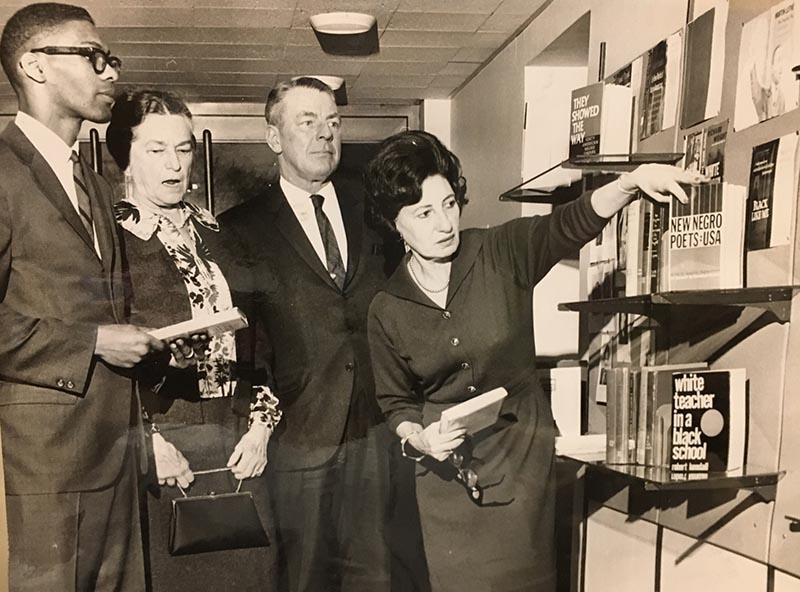
Thomas Mallory viewing a display of
African American and Civil Rights
books at the library
Waterbury American, 26 February 1965
Silas Bronson Library Archives
|
The
library found that the Civil Rights movement led to an increase in requests
from the public for books on the subject. In 1965, the library collaborated
with Thomas Mallory and Kellogg Lodge No. 5 to assemble and promote a
collection of books celebrating African American achievement and exploring
civil rights.
In 1967, the library hosted the city's "Negro History Week" held during February with a two-week exhibit of African American history and a ceremony which included Mayor Frederick Palomba, State Treasurer Gerald Lamb, Thomas Mallory, Isaiah Holley, and Worshipful Master Henry Hardy of the Kellogg Lodge.
|
|
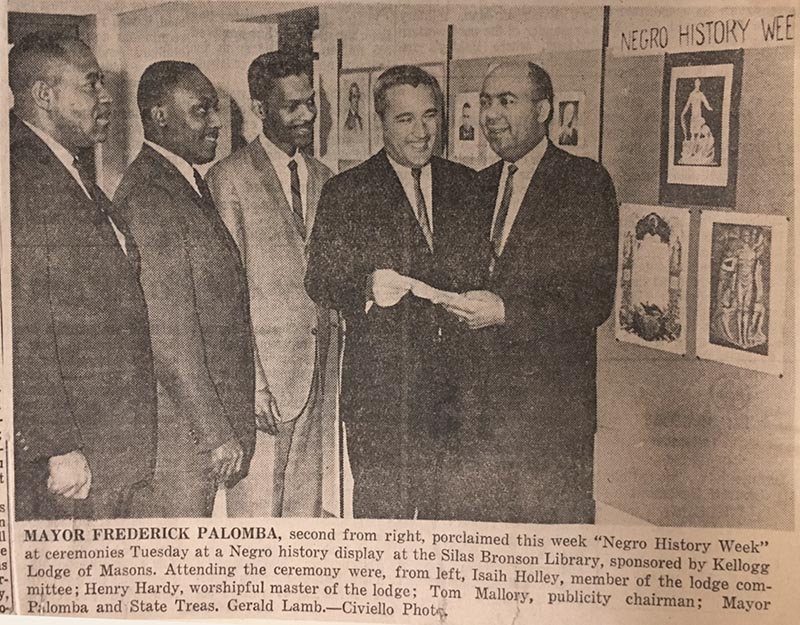 Waterbury American, 15 February 1967 Waterbury American, 15 February 1967
Silas Bronson Library Archives
|
In
1968, after the Waterbury school curriculum was updated to include African
American history, the library suddenly had a increase of requests for
biographies of African Americans.
In 1969, some of the most
popular items at the library included an interim report on the Waterbury Public
Hearings of the Connecticut Commission on Human Rights and Opportunities and a
UConn report investigating racial imbalance in the Waterbury public schools.
|
Main Library Building
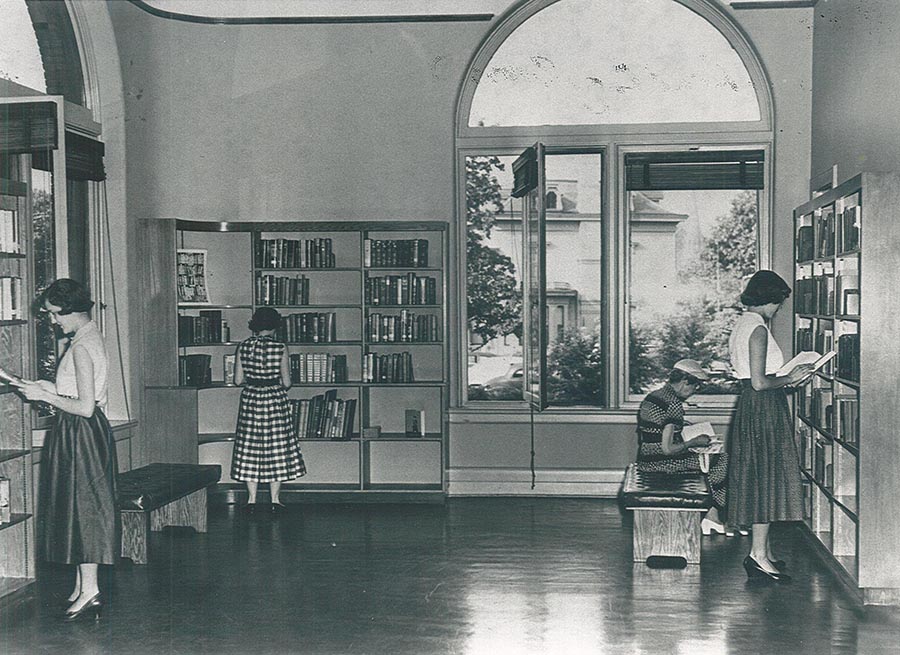
A newly renovated reading lobby, 1953
Silas Bronson Library Archives
|
Constructed
in 1894, the main library building on Grand Street aged poorly and was in need
of frequent repairs and upgrades.
The
first improvements made by Emelyn Barrett to the main building downtown
included the installation of a power-operated elevator in 1930, replacing the
old hand-cranked elevator from the 1890s. Felt and linoleum flooring was
installed in the children’s room in 1930 to “deaden the sound of restless
milling feet” which was disturbing adult patrons on the floor below.
|
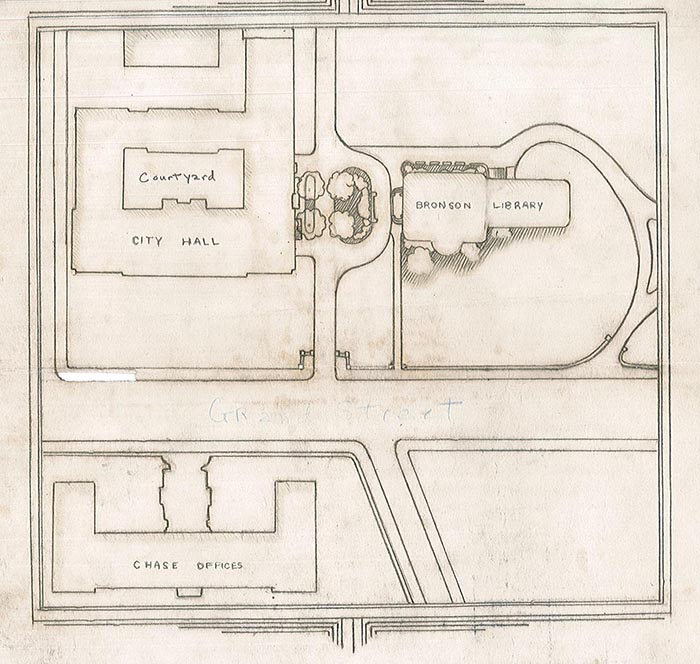
Sketch, 1937
|
Barrett
began campaigning for a new building in 1937, stressing that an 1890s building
simply wasn’t able to meet modern requirements for libraries. She included a sketch
comparing the size of the library to City Hall and the Chase Building to
emphasize the relative smallness of the library.
By
the late 1950s, Barrett (now Mrs. Trimble) was actively raising the funds to
construct a new library building. Although the library had been renovated, it
still wasn’t large enough to meet the needs of the public. The 1890s building
was to be torn down and replaced by a larger, modern building.
|
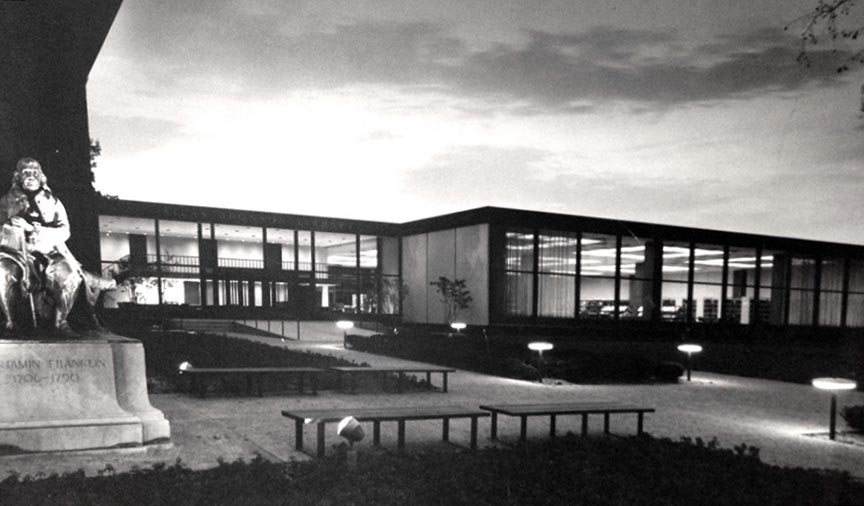
The library in 1964, when the old building
was still standing (behind Ben Franklin)
Silas Bronson Library Archives
|
Local
architect Joseph Stein, who designed the Bunker Hill Branch Library, was
selected to oversee the new building’s design and construction. The new library
was constructed in two phases, replacing the old building while still allowing
a portion of it to be used. Stein won an Award of Merit for Public Library Design
for his work on the Silas Bronson Library from The American Institute of
Architects in 1964.
The
first wing of the library to be completed, which included the Main Reading Room
and the front lobby, opened in October 1963. Construction of the two-story East
Wing began in 1966 and was completed in 1968.
|
Return to Library History
|